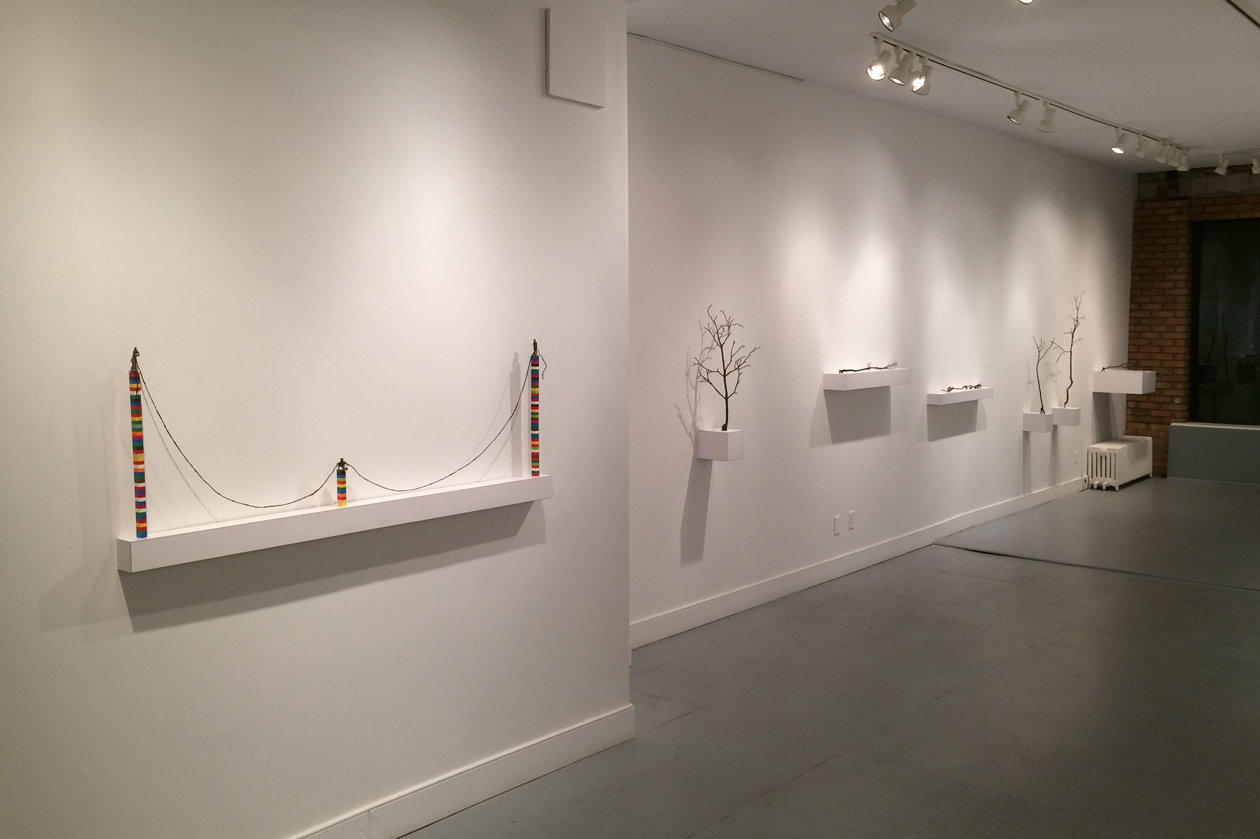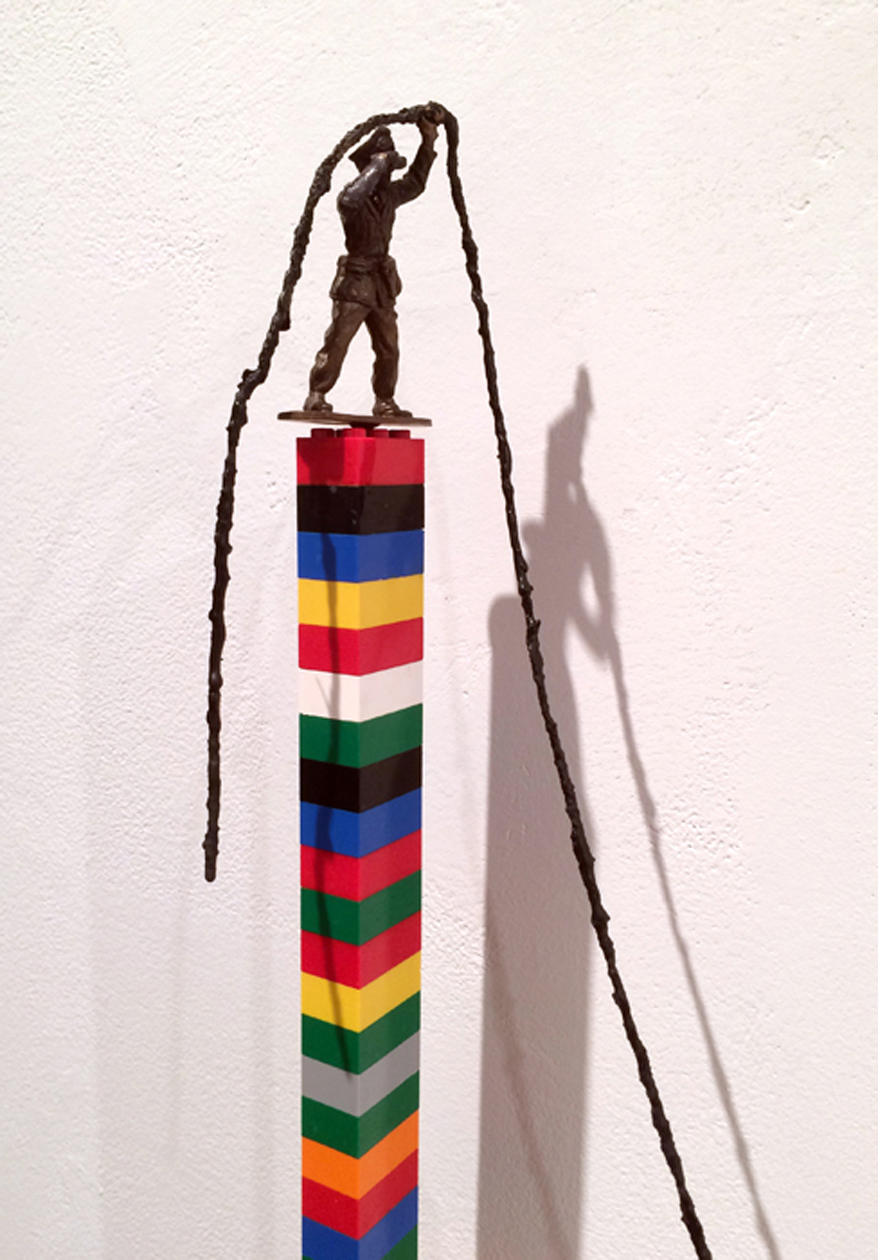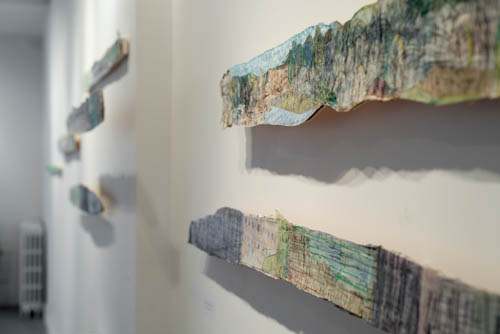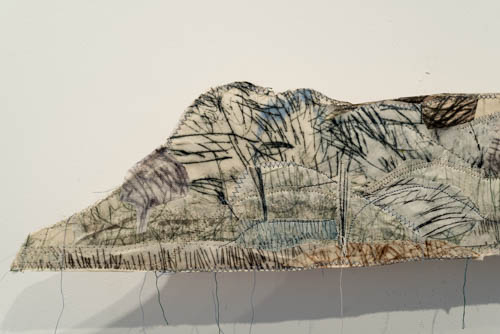Jane LowBeer expresses the visual continuity and layered depth of the rural landscape with a series of impressionistic horizontal assemblages. She experiments with ephemeral moments in nature that are created by the atmospheric conditions of changing weather and light. P. Roch Smith addresses themes of nature and play in material and theme. He demonstrates childlike inventiveness and imagination by unconventionally combining toys with extractions from nature. Both LowBeer’s and Smith’s collections distill the notion of memory in scenarios by thematically removing elements from their original context, combining components and exaggerating scale.
 Installation view of P. Roch Smith, Fields of Play. Courtesy of loop Gallery
Installation view of P. Roch Smith, Fields of Play. Courtesy of loop Gallery
P. Roch Smith’s Fields of Play freezes moments by casting toys and natural elements in bronze, intertwining them and isolating the final compositions on white platforms of varying heights. The result is a series of moments of multiplicity where nature, toys and the audience interact and exchange. Tree branches replace the weapons and sports equipment of action figurines – so the new interactions become more grounded. The eminence of bronze sculpture is made pint-sized and playful. The materiality of nature and plastic become dissolved.
 P. Roch Smith, slackline (detail), bronze and LEGO blocks, 36” (l) x 60” (w) x 24” (h). Courtesy of loop Gallery
P. Roch Smith, slackline (detail), bronze and LEGO blocks, 36” (l) x 60” (w) x 24” (h). Courtesy of loop Gallery
The interaction and exchange of the figurines with their environment exist at multiple scales. The tree branches behave like trees themselves when placed relative to the figures, thereby enabling a real world interaction. Conversely, other compositions create more fantastical circumstances, for example a small character interacts with a massive pinecone. This multiplicity situates the viewer in a immersive but also speculative position. The enlarged shadows created from the small characters and natures add another dimension to this interchange. Smith fixes the toys and natural elements in specific positions with bronze castings and orients them in a permanent direction. While the art is permanent in its situation, the audience has a the freedom to imagine the narratives.
 Installation view of Jane LowBeer, Land Lines. Courtesy of loop Gallery
Installation view of Jane LowBeer, Land Lines. Courtesy of loop Gallery
Jane LowBeer’s Land Lines float on the white wall of the gallery. Approached from a distance and at an angle the arranged composition appears like rugged planks of wood. Face-on a soft impression of clouds appears. Upon approaching the artwork, details of nature become revealed. The multiple layers of the landscape and the chaotic intricacies of nature become prominent. Dominant horizontal stitches imply a horizon line. Layered compositions of different transparencies convey forested areas or the texture of grass covered rolling hills. Each composition reflects a specific moment in the variable landscape of southern Ontario. Multiple textures of varying directions reveal the multiple underlying directions present in the seemingly horizontal landscape. However, the dominant horizontal shapes do connect each composition. The rough edges of the asymmetrical compositions imply extraction and therefore, possible continuity in the real world. Works tilted “Murmur in the Trees”, “There came a Wind”, “Unsuspecting Trees” implicate the collages with additional sonic, haptic, atmospheric and animated layers.
 Jane LowBeer, Murmur in the Trees, drypoint collage and mixed media. Courtesy of loop Gallery
Jane LowBeer, Murmur in the Trees, drypoint collage and mixed media. Courtesy of loop Gallery
Seen in tandem these works together illustrate the various possibilities in illuminating interaction. While Smith physically manipulates the subjects of his work to speak about memory and play, LowBeer creates composite impressions of Ontario’s multifaceted landscapes. Collectively their work imparts ideas about the possible modes of engagement.
Nika Teper
*Exhibition information: October 8 – 30, 2016, loop Gallery, 1273 Dundas Street West, Toronto. Gallery hours: Wed – Thur 12 – 5, Fri -Sat 12 – 6, Sun 1 – 4 pm.
